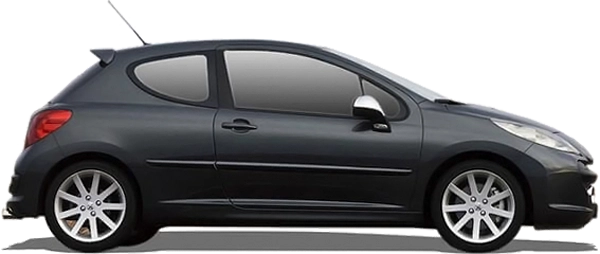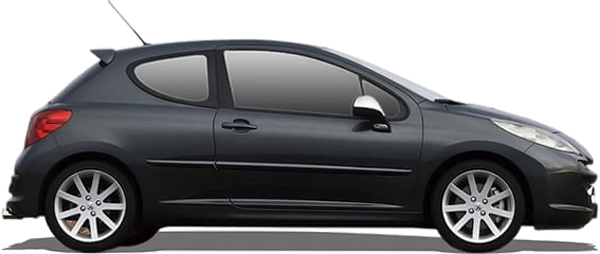The Comparative Analysis :
Peugeot 206 75 (09 - 10) vs. Peugeot 207 HDi FAP 90 (09 - 10)
€ 12,600

€ 14,900

€ 12,600
Base Price ⓘBase price of a new vehicle with standard equipment in Germany at market launch.
€ 14,900
ⓘBase price of a new vehicle with standard equipment in Germany at market launch. Price Info
Vehicle Dimensions
The 206 75 is considerably smaller in every dimension. It's 15.8 cm shorter, 7.9 cm narrower and 2.8 cm lower than the 207 HDi FAP 90.
206 75
207 HDi FAP 90
1444
1669
1903
1472
1748
1972
1669 mm
Width
1748 mm
1903 mm
Width Incl. Mirrors
1972 mm
1444 mm
Height
1472 mm
2443
3872
2540
4030
3872 mm
Length
4030 mm
2443 mm
Wheelbase
2540 mm
Vehicle Weight
206 75
207 HDi FAP 90
1016 kg
Kerb Weight
1296 kg
1421 kg
Gross Vehicle
Weight
Weight
1722 kg

Weight Difference:
280 kg
21.6 %

General
206 75
207 HDi FAP 90
2*
Generation
W*
Hatchback
Car Body Style
Hatchback
Unleaded (95 RON)
Fuel Type
Diesel

Front-wheel drive
Drive
Front-wheel drive

5-speed manual transmission
Transmission
5-speed manual transmission
Engine
206 75
207 HDi FAP 90
Straight-four petrol engine (naturally aspirated engine)
Engine Type
Straight-four diesel engine with turbocharger
2
Valves
4
4
Cylinders
4
1360 CC
Engine Capacity
1560 CC
74 bhp
at 5500 rpm
Power
89 bhp
at 4000 rpm
206 75
74 bhp
89 bhp
207 HDi FAP 90
120 NM
at 3400 rpm
Max. Torque
215 NM
at 1750 rpm
206 75
120 NM
215 NM
207 HDi FAP 90
Performance
206 75
207 HDi FAP 90
107 mph
Maximum Speed
113 mph
13.1 sec
Acceleration 0 to 62 mph
11.5 sec
62 mph
62
mph
mph
182 m
0.000 sec

206 75
62 mph
62
mph
mph
160 m
0.000 sec

207 HDi FAP 90
▶ REPLAY
13.73 kg/bhp
Weight-to-Power Ratio
14.56 kg/bhp
206 75
13.73 kg/bhp
14.56 kg/bhp
207 HDi FAP 90
Fuel Economy / Emissions
206 75
207 HDi FAP 90
Fuel Economy
45 mpg
combined
63 mpg
206 75
45 mpg
63 mpg
207 HDi FAP 90
31 mpg
city
49 mpg
59 mpg
motorway
74 mpg
50 L
Fuel Tank Capacity
50 L
493 mi
Range
690 mi
206 75
493 mi
690 mi
207 HDi FAP 90
Environmental Impact
119.4 kWh
Total Energy Consumption
per 100 miles ⓘThe total energy consumption per 100 miles is the amount of energy consumed by a vehicle when burning fuel or using electricity per 100 miles (final energy), and the energy required to produce the appropriate amount of fuel or electricity (primary energy).
per 100 miles ⓘThe total energy consumption per 100 miles is the amount of energy consumed by a vehicle when burning fuel or using electricity per 100 miles (final energy), and the energy required to produce the appropriate amount of fuel or electricity (primary energy).
92.5 kWh
206 75
119.4 kWh
92.5 kWh
207 HDi FAP 90
Euro 4
Emission Standard
Euro 4, 5L
150 g/km (NEFZ)
CO2 Emissions
120 g/km (NEFZ)
Practical Convenience
206 75
207 HDi FAP 90
3
Doors
3
5
No. of Seats
5
405 kg
Maximum Payload
426 kg
285 L
Boot Capacity
270 L






1130 L
Boot Capacity (Seats Down)
923 L













